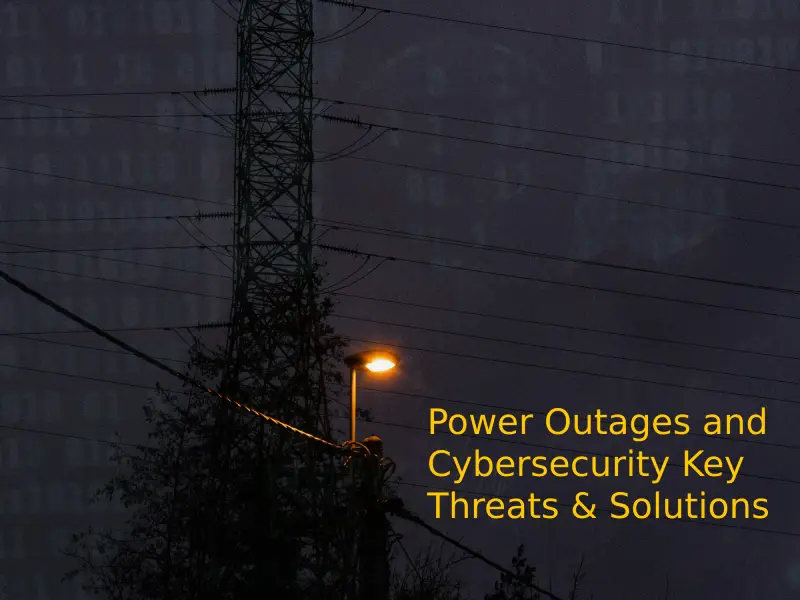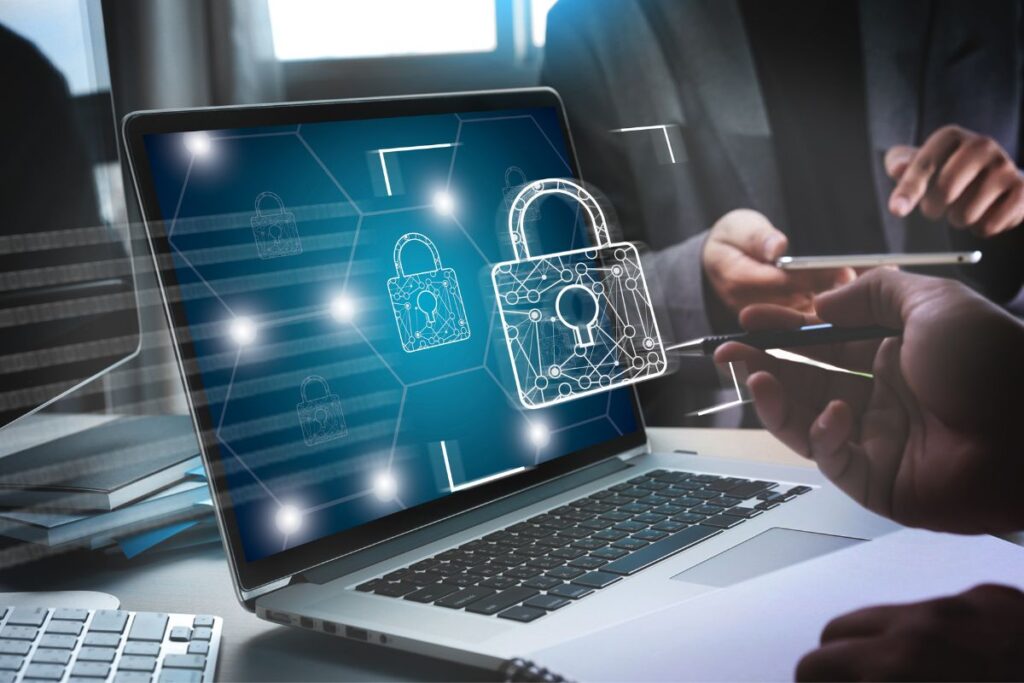Power Outages and Cybersecurity
Power outage and cybersecurity are critical factors that affect modern life, supporting homes, businesses, and critical infrastructure. When a power failure occurs—whether due to natural disasters, technical failures, or cyberattacks—it can disrupt daily operations and create significant cybersecurity risks. Hackers often exploit outages to launch attacks, steal data, or infiltrate systems. Understanding this link between the loss of the electrical power network supply and cybersecurity is essential to safeguarding digital infrastructure and ensuring business continuity.
How Power Failure Weaken Cybersecurity
A power outage can expose vulnerabilities, making organisations more susceptible to cyber security threats. Below are key ways power disruptions impact cybersecurity:
Disruption of Security Systems
Security defences—such as firewalls, intrusion detection systems, and encryption protocols—depend on electricity. A power failure can disable these protections, leaving networks exposed. If backup power solutions are inadequate, systems may remain offline for extended periods, increasing the risk of unauthorised access.
Data Loss and System Failures
Unplanned outages often result in improper shutdowns of servers and storage devices, leading to data corruption or permanent loss. Without power, automated cybersecurity tools, such as anti-malware software and network monitoring systems, may stop working, leaving organisations vulnerable to attacks.
Cybercriminals Exploit Chaos
During outages, businesses focus on restoring power, often overlooking cybersecurity. Hackers take advantage of this distraction by launching phishing scams, deploying malware, or attempting unauthorised access. Fake emails posing as utility companies may trick employees into revealing credentials, worsening the security breach.
Why Hackers Exploit Power Breakdown
Cybercriminals use power failure as an opportunity to compromise systems. Here’s how they take advantage of the disruption:
Exploiting Security Gaps
With power down, outdated systems without robust backup solutions are easy targets. Hackers can infiltrate networks when defences are weakened or disabled.
Distracting Security Teams
A sudden outage diverts attention from monitoring cyber threats. Hackers may simulate power failures to keep organisations focused on restoring electricity while executing silent attacks in the background.
Gaining Physical Access to Infrastructure
Outages may disable surveillance cameras and access controls, allowing cybercriminals to infiltrate data centres, substations, or server rooms to install malicious hardware or extract sensitive data.
Data Theft and Ransomware Attacks
With cybersecurity defences down, hackers can exfiltrate confidential information or deploy ransomware, encrypting critical files and demanding ransom payments to restore access.
Targeting Critical Infrastructure
Power-dependent sectors, such as hospitals, emergency services, and transportation networks, are prime targets. Cyberattacks during outages can cause operational shutdowns, public panic, and financial losses.

Notable Cyberattacks Involving Electrical breakdown
Real-world incidents highlight the devastating impact of Electrical breakdown on cybersecurity:
Ukraine Power Grid Attacks (2015 & 2016)
Hackers infiltrated Ukraine’s power grid, causing blackouts affecting over 225,000 people. A year later, another cyberattack left Kyiv in darkness. The attackers used malware and phishing techniques to gain access, showing how power infrastructure can be weaponised.
Industroyer Malware (CrashOverride)
This malware specifically targeted power grids, manipulating control systems to cause outages. It proved the risks of outdated infrastructure and the need for stronger cybersecurity measures.
Cascading Failures in Interconnected Grids
Cyberattacks on distributed energy systems, such as solar and wind farms, have led to cascading power failures. Without coordinated security policies, these disruptions can spread across regions, amplifying damage.
Cybersecurity Risks in Smart Power Grids
IoT Devices as Entry Points
Smart grids rely on IoT sensors and automated systems that can be hacked if they lack proper security updates. As internet-connected devices, they can be hacked, manipulated, or disrupted, creating multiple entry points for cybercriminals. These vulnerabilities pose significant risks to the overall security and stability.Automation and AI Vulnerabilities
Hackers can manipulate automated controls to disrupt power distribution, causing blackouts or system failures.Security Challenges in Decentralised Energy Systems
Renewable energy sources, such as solar panels and battery storage, run on decentralised networks. If not secured, these systems can be compromised, leading to widespread power disruptions.Mitigating Cyber Risks During Power Outages
Protecting cybersecurity during electrical failure requires an initiative-taking approach. Key strategies include:
Backup Power Solutions
- Deploy uninterruptible power supplies (UPS) and generators to support security operations.
- Invest in solar power with battery storage to reduce reliance on traditional grids.
Strengthening Cybersecurity Defences
- Use multi-factor authentication (MFA) and strong encryption to prevent unauthorised access.
- Deploy AI-driven threat detection to monitor suspicious activities in real-time.
- Regularly update security software to patch vulnerabilities.
Employee and Stakeholder Training
- Train staff to identify phishing emails and social engineering scams during outages.
- Develop incident response plans to manage cyber security threats effectively during disruptions.
Securing Physical Infrastructure
- Enhance security at power stations, data centres, and substations to prevent unauthorised access.
- Install backup surveillance systems that are still operational during power failures.
Government and Industry Collaboration
- Strengthen coordination between governments, utility companies, and cybersecurity experts.
- Develop national policies to secure critical infrastructure from power failure-related cyber threats.
- Cybersecurity assessments should be mandatory for all internet-connected devices, ensuring compliance with robust security standards.
- A security rating system for critical IoT devices can help organizations identify trustworthy solutions and prioritize their deployment.

How Technisaur Can Empower Professionals and Employees
Technisaur can play a pivotal role in helping organizations strengthen their defences and prepare employees for potential cyber security threats during outages.
Training and Development
Technisaur can offer engaging e-learning modules, workshops, and simulations to train employees on cybersecurity best practices and threat identification. By integrating gamified learning experiences, Technisaur can make training accessible and impactful.
By empowering professionals and employees with the knowledge and skills to recognize and respond to cybersecurity threats.
Culture of security
Technisaur can help organizations create a culture of security awareness and preparedness. Risk Assessment and Management Technisaur can recommend tools and resources for conducting risk assessments and developing risk management strategies. By identifying vulnerabilities and implementing proactive measures, organizations can better protect their systems and data from potential cyber-attacks.
Incident Response Planning
Technisaur can help in developing and testing incident response plans to ensure that employees are prepared to respond effectively to cybersecurity incidents. By practicing and refining response procedures, organizations can minimize the impact of cyber-attacks and mitigate potential damage.
Preparing for the Cybersecurity Risks of Power Breakdown
The link between electrical failure and cybersecurity is undeniable. Whether caused by natural disasters, cyberattacks, or technical failures, power disruptions create vulnerabilities that hackers actively exploit. Businesses and governments must adopt initiative-taking cybersecurity measures, including backup power solutions, robust security protocols, and stakeholder training.
As power grids evolve into smart grids, securing these systems against cyber threats becomes even more critical. By strengthening cybersecurity defences, investing in modern infrastructure, and fostering collaboration, we can protect critical services and reduce risks during loss of electrical power network supply.
Technisaur’s security training programs provide Australians with the tools and knowledge to turn risks into resilience.
Learners can access materials and complete assignments at their convenience, making it ideal for those with busy schedules or other commitments.
Students can spend more time on challenging topics and less on easier ones, catering to their individual learning styles.
This method is suitable for diverse audiences, including those with geographical, scheduling, or physical constraints.
Encourages self-regulation, time management, and discipline, which are valuable life and professional skills.
Reduces costs associated with commuting, classroom maintenance, and printed materials.








